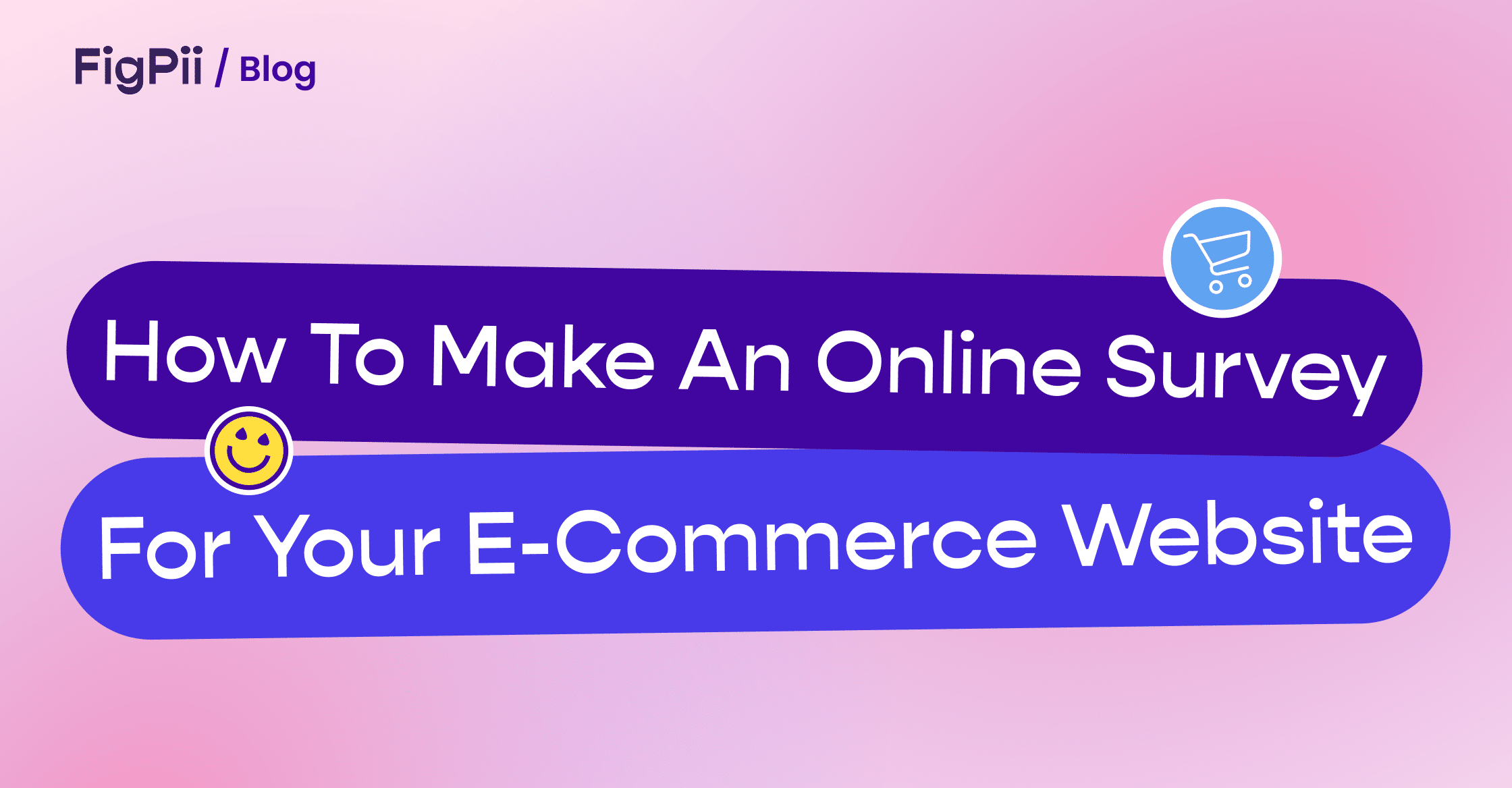Have you ever visited an e-commerce website and felt like the website didn’t offer the products you were looking for? Or maybe the checkout process was too complicated? Or, you couldn’t find your preferred payment method?
You’re not alone – nearly 70% of online shoppers abandon their carts before completing their purchase.
Clearly, as an e-commerce business owner, it’s crucial to understand why your customers behave the way they do.
One way to gain valuable insights is through customer feedback surveys and the said survey responses.
A customer survey that asks the right questions will help you discover what your customers want and need and duly make changes to improve their experience.
In this step-by-step guide, we’ll show you how to create customer surveys and ask the right ecommerce survey questions to gain insights into the customer experience.
Step 1. Determine Your Survey Goals
Identify the goals/objectives of your survey.
Determining your survey goals is the first step in creating an online survey for your e-commerce website.
The goal of your survey can be to generate ideas, gather feedback or get customer information.
You can use an online survey to determine the following:
The most effective way to market products and services.
What do customers like about your business, and what do they not like about it?
Are there new products they would like to see added to your inventory?

What price point would be most profitable for a specific product or service?
Here are some essential steps you can follow to determine your survey goals:
- Define the purpose of your survey: Before you begin creating your survey, you need to define why you’re conducting it. What is the main goal or objective you want to achieve? For example, you may want to gather feedback on your customer service, product offerings, or website usability.
For example, Zappos, an online shoe and clothing retailer, uses website surveys to gather feedback regarding their experience with their website and overall service.
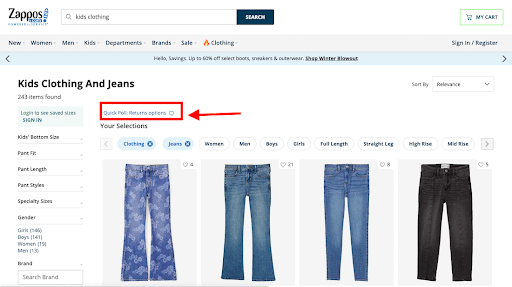
You’ll get redirected to a new tab to fill out surveys based on your satisfaction with their return process, checkout process, customer service, etc.
- Who is the target audience? To gather relevant feedback, you’ll need to know beforehand who your survey is intended for and tailor your questions accordingly. Consider demographic factors like age, gender, location, and purchase history (More on this later).
- Do you have any goals: Once you have a clear idea of your purpose and audience, you can set specific goals for your survey. For example, you may want to increase customer satisfaction, improve website navigation, or identify new product ideas.
Once you’re privy to this information, you’ll be better positioned to create relevant surveys and gain relevant answers.
Define your target audience.
Most surveys have one thing in common: they need a target audience.
And defining your target audience beforehand is essential because it will affect the type of questions you ask and how you ask them.
For example, if your target audience consists of mothers with children under three years old, surveying about vacations is probably not relevant. For these moms, the top priority may be something. Something like finding suitable childcare arrangements or baby clothes.
Clearly, your survey questions will directly correlate with your target audience.
Here are some ways to define your target audience:
- Which demographics are most likely to use your product? Does your target audience consist primarily of men or women? What’s their age? What about the income group? Do they live in cities or suburbs? Do they have kids? How many kids?
- Who will benefit the most from your product? What kind of person would be interested in this kind of product? What motivates them? Where do they spend time online?
- Look at your social media followers: Use social media to learn more about the people who follow and interact with your brand online. This will give you a better idea of what type of person would be interested in shopping from your store or learning more about you.
Step 2. Choose a Survey Tool
Research different survey tools available.
Now that you’re familiar with your target audience and know what to ask them to get the most relevant insights, it’s time to put it all into action. It’s time to finally create your survey.
However, before the final design process, you need a tool that will make the process a breeze.
And that’s where online survey tools come into the picture.
And fortunately, there are multiple survey tools you can use to create an online survey for your e-commerce website.
Here are some of the best options available right now:
- FigPii: A user-friendly survey tool that allows you to create surveys with various built-in question types and templates. It also offers advanced features such as branching and skip logic.
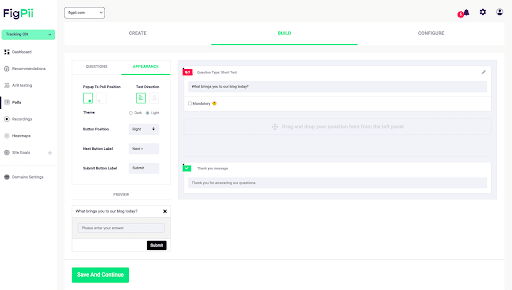
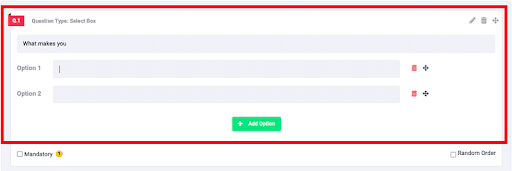
- SurveyMonkey: This is one of the most popular online survey tools today. You can create surveys using templates and pre-built question types and customize them to align with your needs.
- Google Forms: A free and straightforward survey tool that lets users create surveys, quizzes, and polls with various questions. It’s free and integrates seamlessly with Google Drive. All responses get automatically saved there.
- Typeform: Typeform’s USP is its ability to create visually appealing surveys in a more conversational style.
While researching, consider features and pricing carefully.
For example, ask yourself if you need more than basic data collection or advanced features like mobile support or location-based targeting.
Consider what you want from your online survey tool before deciding which tool is best for your business.
Step 3. Create Your Survey
Decide on the type of questions you’ll ask.
You won’t get the best survey results by just asking questions about your products. You actually need to ask the right questions.
And the right questions will depend on your goals and the reason you’re running the survey.
For example, pre-purchase or post-purchase questions will help you gauge customers’ satisfaction with the products they purchased from your site.
Then you have product-related questions that will help you understand why customers buy one product over another. Review-related questions will provide insights into customers’ satisfaction with their overall experience with your website, buying process, and products.
Look at this post-purchase survey from Zoe, a brand that offers lightweight, compact strollers and targets families that travel frequently.
The first survey question asks the customers to rate the product they purchased from Zoe.
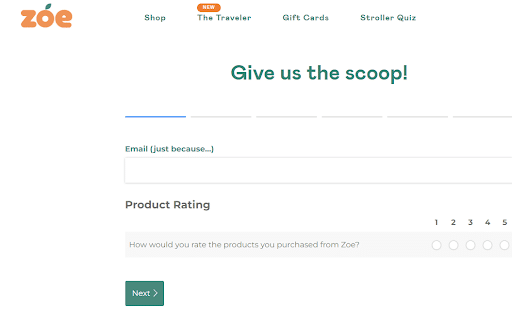
(Source)
Next, the question asks whether they’d recommend Zoe to others or not. They also ask what new products they would like to see in the future.
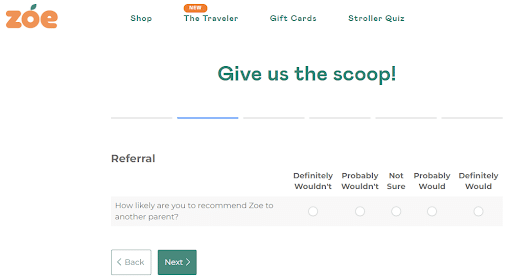
(Source)
Choose the survey format (multiple-choice, checkbox, drop-down, etc.)
When you have chosen the exact questions you want to ask your customers, it’s time to create a template for your ecommerce survey. The first thing you need to do is choose the survey format.
There are many types of ecommerce surveys, and each one comes with its advantages and disadvantages.
Here are some of the most common types:
Multiple choice: Here, website visitors get a set of pre-defined answers. They’re easy to analyze and provide quantitative data but may not capture the full range of opinions or experiences.
For example, you may ask, “How frequently do you shop on our site?”
- Daily
- Weekly
- Monthly
- Rarely
- Never
Rating scales: Here, you’ll ask visitors to rate their experience on a scale – from 1-5 or 1-10.
For example, you may ask, “On a scale of 1-5, how would you rate the ease of navigating our site?”
Open-ended: Here, you’ll ask the respondents to provide an answer to an open-ended question.
Example: “What do you think we could do to improve your shopping experience on our site?”
Demographic questions: These questions intend to gauge basic demographic information of the target audience, such as age, gender, or location. You can use them to segment responses and identify trends among different groups.
Example: “What is your age range?”
- 18-24
- 25-34
- 35-44
- 45-54
- 55+
And these are only some of the few options you have. Many tools offer numerous other options like select box, radio, etcetera. You can also add images and text boxes to make your ecommerce surveys more attractive and engaging.
Consider whether you need to include any logic to skip over questions.
If a few of your survey questions are only relevant to specific customers, it makes sense to use logic in your online survey to skip over them.
For example, let’s say you created an online survey to gather customer feedback about a new product. If the new product were only available in Europe and North America, you would only want to ask people living in these regions about their experience.
To do this, create an exclusion question at the beginning of your survey that asks, “What country do you currently live in?” Then add logic on the next few questions that check whether they should be skipped based on their answer to this question.
If they mention the countries from the European or North American region, then continue on with the rest of your survey. If they’re from different countries, then send them directly to the next question.
Look at this survey, for instance:
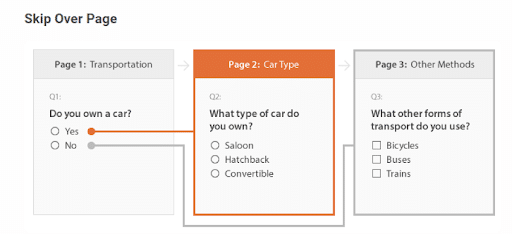
(Source)
In the survey above, people who don’t own a car can skip the second page asking, “What type of car do you own?” They can instead answer the third question, “What other forms of transport do you use?”
Keep the design simple and visually appealing.
If you want to create an excellent survey, make sure you stick to a single purpose and keep everything else out of the way.
The more complicated your survey, the harder it is for your target audience to understand what you’re asking them or what they should do in response. Too much chaos might even frustrate them into abandoning the survey right away.
Look at this on-site survey by Apple to get feedback on their products:
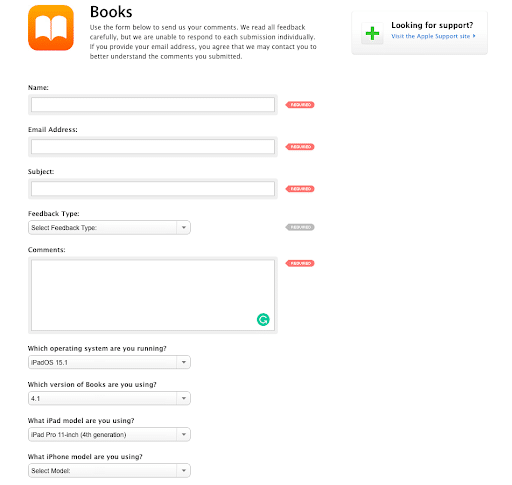
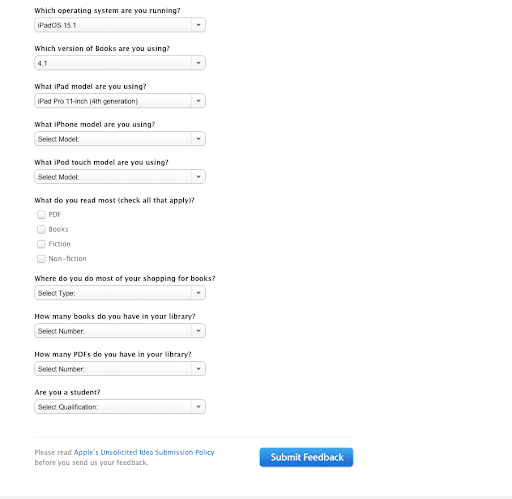
(Source)
The survey has a modern and sleek design with easily comprehensible questions. The response options are also clearly labeled.
Ensure the survey is mobile-friendly.
Gone are the days when people had to turn on a bulky computer system to access a simple website.
Now everything is accessible on the go on your compact, 5-6 inches mobile screen.
In fact, everyone’s so hooked to their mobile screens these days – that’s likely where they’ll view your surveys.
Here are some quick tips to make sure your ecommerce surveys are mobile-friendly:
- Use a mobile-responsive design: Use a responsive design that adjusts to different screen sizes and resolutions. This ensures that your survey is easy to read and navigate.
- Optimize for mobile devices: Your font size and buttons should be large enough, allowing users to tap with a finger easily. Also, use a simple layout that works well on smaller screens.
- Test on multiple devices: Test your survey on numerous devices and platforms to ensure it works well on all of them.
- Avoid using flash or other plugins: Flash and other plugins may not work on all devices – use HTML5 and other mobile-friendly technologies instead.
- Use a mobile-friendly survey platform: Use a survey platform designed to work well on mobile devices. Many popular survey platforms, such as FigPii, have mobile-friendly options.
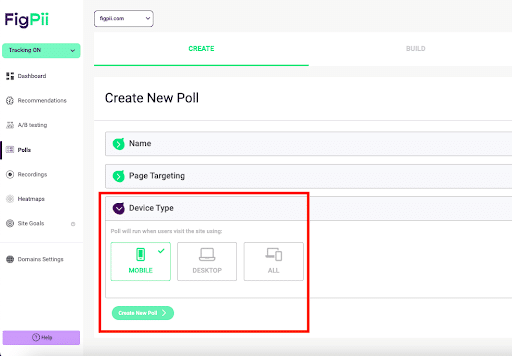
Offer incentives
We all love free stuff. And if you’re trying to get responses from your online ecommerce survey, offering an incentive can help.
The best way to incentivize your respondents is by offering them a chance to win a prize or receive something for free.
This could be anything from a coupon code, discount, or free product to an actual prize that they’d receive after completing the survey.
It just needs to be something that will motivate people who are taking the survey. For example, if you run a clothing store and want feedback on how customers feel about your latest collection, offering a $10 gift card would likely get more responses than just asking for feedback alone.
Conduct a trial run to test the survey’s functionality
Now that you’ve created your survey, you’re probably impatient to see the answers pouring in.
But not so fast.
The next step should be to do a trial run to ensure everything works as intended.
Why? This will help you identify any mistakes or issues with the survey design before sending it out to a larger group.
You can also use this test to determine how long it takes people to complete the survey, if they have any questions about the survey questions, or if there’s any confusion about your questions.
Step 4. Launch Your Survey
Promote the survey to encourage participation.
Once your survey is ready, you must promote it through your network.
The most effective way to do this is by emailing a link to your survey to friends and family. You can also share it on Facebook, Twitter, or other social networking sites.
The more people who take your survey, the better the results will be.
Monitor responses and analyze the results.
Congratulations! You’ve built and launched your survey.
Now it’s time to monitor responses and analyze the results.
You’ll be able to get insights into different metrics based on the survey tool you’re using.
For example, FigPii gives you access to a detailed “Report” that provides a survey breakdown based on factors like date, location, device type, and more.
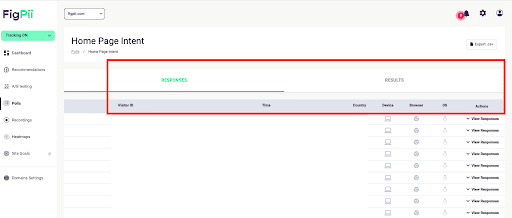
You can also view individual response details by clicking on a specific response.
While monitoring results, pay attention to questions that received multiple answers or those with low response rates. The reason for their low response rates may be the need for further explanation or rewording before sending them out in future surveys.
Over to You!
E-commerce survey questions work like a charm when collecting customer feedback. Online shopping survey questions also help you discern how your customers interact with your website, giving you insight into how to optimize it.
An optimized ecommerce website leads to more customers. More customers mean more sales. And the more sales you have, the more you can spend on the design and aesthetics of your ecommerce store.
In the end, the idea is to get as many people as possible to take your ecommerce survey so you can collect relevant and valuable information from the target market.

